As published in Law Enforcement Technology Magazine, January 2006
The Shotgun Speedload
by Dave Brown
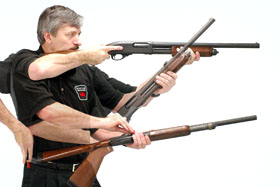
Nothing matches the versatility of the police-issue shotgun. In the right hands, it is fast and accurate at typical encounter distances and packs enough of a wallop to stop deadly threats instantly. Its flexibility in ammunition selection is unmatched by any other weapon and its lack of a large magazine capacity is not a detriment if officers can be taught how to properly reload the shotgun when empty. With proper training that parallels advances in modern handgun training and acknowledges the scientific behavior of the human body under stress, this century-old weapon can still be effectively employed today.
In an emergency the pump-action shotgun can be quickly reloaded with one more shell by simply dropping it directly into the ejection port. This technique is called speedloading and is a necessary component of basic shotgun training. Unfortunately, the speedload has been overly complicated by techniques more applicable to those playing ‘gun games’ or tactical officers who have the luxury of regular practice on techniques that may not be immediately instinctive.
This article will instead review what works for the average person, under stress and without the ability to practice hours a month. This technique works reliably for the average person with minimal training. It emphasizes simplicity, consistency, conservation of motion and an understanding of the performance limitations of the human body under stress.
Lessons from CERU
The typical police pump-action shotgun can discharge anything from light training loads to duty buckshot to powerful slugs for punching through cover or dispatching wounded wildlife on the highway. An even newer option is less-than-lethal projectiles such as the bean-bag rounds and the latest variation of “sock” rounds, which can be deployed in certain situations in lieu of deadly force.
One example of the effective deployment of shotguns by agencies who use them rarely is in correctional facilities. Standard police duty rounds would be potentially hazardous to both inmates and staff alike. This is where impact weapons would be most effective.
However, one common myth is that impact weapons such as shotguns loaded with sock rounds do not have to be fired as accurately as standard buckshot or slug rounds. In fact, the opposite is true; impact rounds require more accuracy.
One industry-leading example of the deployment of shotguns for the exclusive use of various impact projectiles has been found at provincial correctional facilities in Manitoba, Canada. Here, Corrections Emergency Response Units (CERU) have now adopted the pump-action shotgun as a less-than-lethal projectile option after suffering through the worst prison riot in their history in 1996. For a period of twenty-four hours, inmates took over much of the Headingly Correctional Facility, causing millions of dollars in damage and inflicting serious injuries to officers and other inmates. To deal with such explosive situations in the future, the CERU teams needed impact weapons that could be rapidly deployed, accurately fired and capable of reliable speedloading under stress. For them, the shotgun proved ideal.
Denis Litster, former head of training for Manitoba Corrections and past instructor at the Northwest Law Enforcement Academy in Winnipeg, explains, “Unlike other emergency response teams, when a hostage situation happens in a correctional facility, we need to go in right away. We don't have the luxury of waiting them out. Our tactics are unique and our shotgun shooters need to be able to top up, speedload and switch ammunition types instinctively.”
Speedloading became a critical component of their shotgun training and is now included as part of their qualifying skills. Litster emphasizes how vital that skill is to their tactics. He reports, “We need our shooters to finish each scenario with as much ammunition in the shotgun as what they started with. When we saw the proper way to speedload a shotgun, we knew right away that this was the only method that would work for us. It's quick, it's smooth and - most important - it’s dead reliable.”
Traditional Speedloading
Whether the police shotgun is loaded with buckshot, slugs or less-than-lethal projectiles, there needs to be a reliable plan for when the officer runs out of ammunition before the threat has been neutralized. A spare round can be taken from the pocket and dropped directly into the ejection port, bypassing the magazine tube entirely and hopefully concluding the situation with one more shot.
A speedload differs from a top-up reload. A top-up reload is completed on a partially full magazine, while a speedload begins when the shotgun is fired until empty and concludes when one further round is loaded and immediately fired to stop a threat. This can be considered the “immediate action drill” for shotguns, and should form the bulk of reload training. (A sudden ‘click’ while still engaging a deadly threat is not the best time to be learning new skills.)
All photos assume a right-handed officer. (When teaching left-handed officers who are often more ambidextrous, instructors can demonstrate several methods to find the one that works the best.)
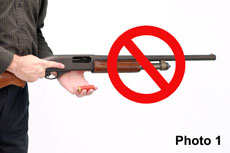
On the surface, this seems like a fairly reliable way to speedload a shotgun and seems to work effectively on the training range. It even has an apparent bonus in that the shotgun never leaves the shooter's strong hand; ready for immediate action even at waist level. Unfortunately, the term "immediate action" is pretty loose, considering we are dealing with what is essentially an empty shotgun at this point. Worse yet, this method violates every rule about gross versus fine motor skills that we have learned in the last thirty years.
When the weak hand is forced to depend on fine motor skills such as in this method, the stress of a real situation almost guarantees that the officer will fumble hopelessly with the shell while retrieving it from the pocket or accidentally toss it over top of the receiver. Some shooters have even been known to try to chamber a shell backwards during the panic of a real encounter.
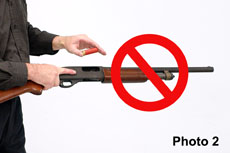
Due to the unreliable nature of this first method in real life encounters, a second variation has been taught where the shotgun is held in the right hand, tilted to the side, and the shell is dropped into the port from above. (See photo 2.) Unfortunately, this method suffers from the same loss-of-fine-motor-skills problem as the first method, complicated by the tilted nature of the ejection port making for a much smaller target.
Test either method on the training range under tight time limits and the reliability of either one quickly deteriorates. To be considered effective, a shotgun should be speedloaded with a maximum of three seconds from shot to shot.
Teaching The Modern Speedload
So how do we resolve the loss of fine motor skills in high stress situations with the need to drop a shotgun shell directly into the ejection port of an empty shotgun? The solution is actually quite simple - and not really all that revolutionary either.
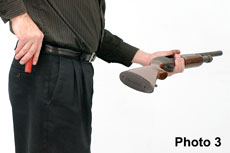
The shotgun is held flat in the left hand at its natural balance point, with the open hand cupping the receiver right at the ejection port. At the same time, a spare shell is retrieved from a right-side pocket with the right hand. (See photo 3.)
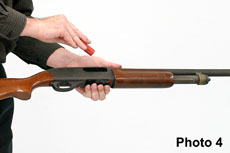
The spare shell is simply dropped into the ejection port with the right hand. The shell does not need to be fed carefully; the only thing the shooter needs to worry about is getting the front of the shell towards the front of the gun. (See photo 4.) Even if the shell misses the hole, it will be trapped by the left hand and still fall into the port.
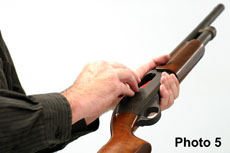
Once the shell lands inside the port, it will chamber as soon as the pump moves forward. (See photo 5.) The shell lifter straightens the shell out and guides it directly into the chamber, the shotgun is transferred back to the shooting grip as the pump is racked forward and the sight aligned with the potential threat. If necessary, the shot can be immediately fired.
While it might seem counter-intuitive to switch hands while speedloading, the fact is that this method is the only one that emphasizes gross motor skills for holding the shotgun and fine motor skills for dropping the shell into the chamber. Any officer who has ever been late for work and dropped their car keys on the ground will understand the rationale for this technique immediately.
To illustrate how instinctive this method is, simply watch the average right-handed officer loading a shotgun into the magazine tube when they are not under stress. You will notice that the vast majority of people hold the shotgun in their left hand and feed the shells into the tube with the right hand. The reason they do this is because it is the most comfortable way of doing it with the least amount of fumbling.
So now one has to ask why we have traditionally trained officers one way to load a shotgun when not under stress and a completely different way of loading when they are under stress. This can be a recipe for disaster.
For those agencies still teaching the old way, all I say is try both methods under stress. The older methods of training tend to fall apart quickly when a timer starts running and speed really starts counting.
For the ultimate test of shotgun ability, try my “five-in-five drill” where the shooter faces five reactive targets at seven yards, with four shells in the shotgun and one in their pocket. They have five seconds to knock down all five targets.
This test is tough, but if it can be accomplished within the time limit, then you know speed, accuracy and speedloading ability have all be tested to near their maximum potential.
Training Pays Off
In an ideal world, every officer would have a sidearm on their hip and a shotgun and patrol carbine in a rack behind the front seat. There is no reason that a patrol carbine needs to replace the shotgun. They are both unique in their intended purposes.
With good training, the shotgun can be the versatile and effective weapon it was designed to be, and properly trained shooters can utilize it for both its rapid multiple shot capability and even its psychological impact.
Years after the shotgun was introduced into provincial correctional facilities in Manitoba. Denis Litster is proud of the record his CERU teams were able to achieve in operational deployments. “In every situation, the subject complied without us having to fire a shot. We dramatically lowered injuries to officers and inmates and we substantially reduced the potential damage to our facilities. The cost saving alone was incredible.”
This illustrates how good training; good techniques and good officers can make a formidable combination.